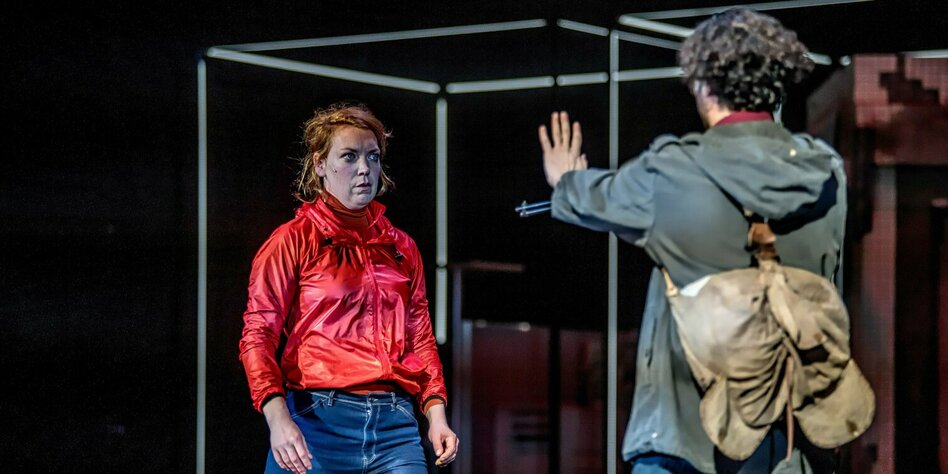Doomsday At the Schauspielhaus Hamburg Man take a break

Doomsday at the Schauspielhaus Hamburg: Man, take a break According to "The Long Sleep," nature is supposed to reclaim its habitat. The dystopia created by Finnegan Kruckemeyer is staged by director Philipp Stölzl.
The only people awake while the rest of the world sleeps are Lina Beckmann and Mehmet Ateşçi. Photo by Knut Koops Doing nothing. Silence.
Perhaps that would be the answer and the final way out to stop the destruction of the world. That is, at least, Emily's vision.
Mankind would have to be put into a year-long "long sleep" with the assistance of an anesthetic gas, as opposed to searching for a new habitat in space. The Hamburger Schauspielhaus hosted Philipp Stölzl's german-language premiere of Finnegan Kruckemeyer's play, "The Long Sleep," which was written by the author.
This dystopia's central thesis is that if everyone slept, all environmental destruction caused by humans would stop. The dystopia is set in the year 2030. By that point, nature would have had time to reclaim its habitat.
In Kruckemeyer's play, however, Emily (Sandra Gerling) is only a minor government advisor. As a result, the choleric minister (Samuel Weiss) appropriates her idea, stirs up trouble, spreads it, and, after the first act of this doomsday scenario, artificially puts everyone into a coma. But all of humanity? No! Two people with indomitable lungs who were grown in a lab provide resistance. The best-selling Australian author may have believed that the second act must contain some sort of event.
During this "sabbatical for nature," someone needs to report on what goes well and what doesn't. The two who stayed awake are a man and a woman, so that it can also be a little romantic or possibly even heavenly.
Fortunately, they go by the names Maggie and Pete instead of Adam and Eve. Lina Beckmann and Mehmet Ateşçi portray the two of them in Sleeping Beauty with Consequences, and they transform the encounter—which the author has fairly constructed—into a significant, tender, moving, wild, and alienating scene between red wine and backpack, during which fluffy clouds move over empty streets in clips (Melwin Noe).
and the asphalt is free of any cars, reflecting red traffic lights. In the third act, as people begin to awaken once more, they witness swarms of birds and bees in addition to dead cows, wild dogs, and burned people.
It was difficult due to the artificially induced sleep. In Australia and Nigeria, there were forest fires and floods that resulted in the deaths of friends, family members, and children.
A second lockdown is equally contentious, and Emily, who has since shot to fame as a prominent influencer around the world, ruffled some feathers with her comment that "Silence is potent.". Silence has great power.
The text by Kruckemeyer is a very ambitious work of theater. That wants to examine its dozen characters in depth in addition to trying to negotiate the global climate catastrophe, which extends from Australia to Argentina.
She wants to project a friendly demeanor and make her actions clear. wants to share stories about friendships and daily life, about science and technology, about people's fates, their deaths, the end of the world, and their visions.
of lies, love, megalomania, greed, resentment, and megalomania. How beautiful is the end of the world? The multiple award-winning Australian author succeeds - how could it not? - in the form of clichés: egomaniacal politician, diligent assistant, superficial moderator, ambitious speaker, caring mother, loving father, and a child full of undisguised wisdom.
Despite this incredibly template-like environment, the staging is worth viewing in some places. Philipp Stölzl creates exquisite, incredibly realistic miniatures in a set of six cubes surrounded by neon tubes.
At the same time, he paints portraits of various lives in a way that is both narrative and spotlighted, with a cast that makes every effort to understand at least some of the shallows of the characters. But the longer the evening goes on, the more he wants to shock as well as to tell and explain.
Over and over, images of fires, floods, and droughts, as well as plastic waste and other natural disasters, are shown in razor-sharp, all-pervasive catastrophes. The question of whether one can truly predict the end of the world using crude clichés, fantastic actors, moody live music performed by a string quintet (Tristan Breitenbach), and highly artistic photographs of environmental catastrophes quickly arises.
As though it were an easy-to-understand yet extraordinarily lovely thing. A string quintet's moody live performance (by Tristan Breitenbach) and exceptionally beautiful images of environmental disasters can effectively convey the end of the world.
As though it were an easy-to-understand yet extraordinarily lovely thing. A string quintet's moody live performance (by Tristan Breitenbach) and exceptionally beautiful images of environmental disasters can effectively convey the end of the world.
As though it were an easy-to-understand yet extraordinarily lovely thing.
At the same time, he paints portraits of various lives in a way that is both narrative and spotlighted, with a cast that makes every effort to understand at least some of the shallows of the characters.
Post a Comment for "Doomsday At the Schauspielhaus Hamburg Man take a break"